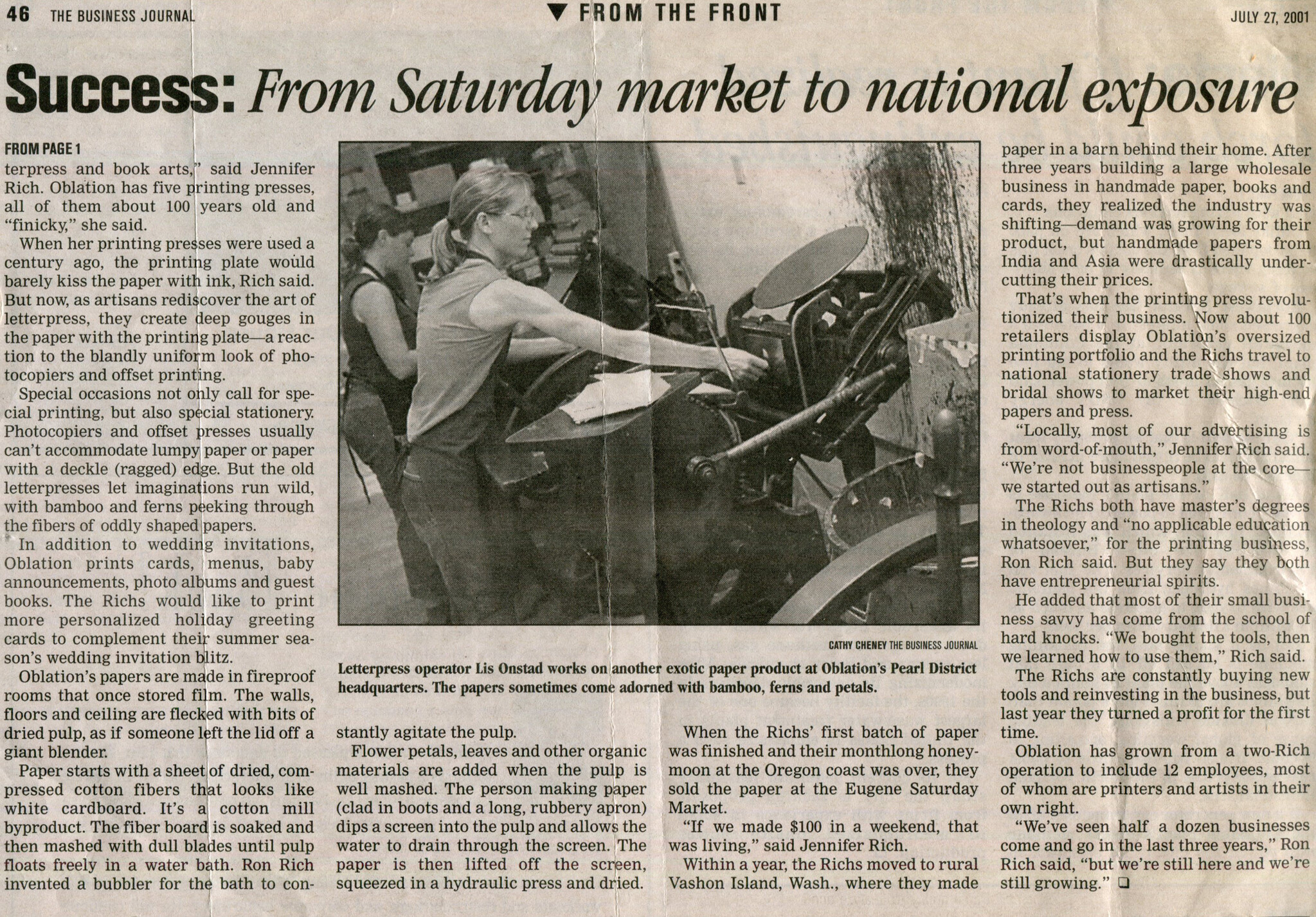Oblation History: Paper-making book and blender lead to success
- Posted on
- By Cathy Cheney

Paper-making book and blender lead to success
by Cathy Cheney, July 27, 2001, The Business Journal

Twelve years ago, Ron and Jennifer Rich took a blender and a paper-making book on their honeymoon.
They knew it would be the beginning of a lasting marriage.
They didn't know it was also the beginning of a thriving business.
Oblation Papers & Press has flourished in a Pearl District warehouse for the past three years, recording about $500,000 in gross sales last year.
Although it has only one retail outlet at 516 NW 12th Ave, it also has 600 wholesale customers in North America who buy its handmade papers and specialty printing services.
About two-thirds of the Richs’ business is wedding invitations, which often combine flower- or leaf-infused paper with letterpress printing. Unlike engraving and embossing, which makes letters stand out from the paper, a printing press depresses the letters, “biting” into the paper.
“There has been a revival in the letterpress and book arts,” said Jennifer Rich. Oblation has five printing presses, all of them about 100 years old and “finicky,” she said.

When her printing presses were used a century ago, the printing plate would barely kiss the paper with ink, Rich said. But now, as artisans rediscover the art of letterpress, they create deep gouges in the paper with the printing plate - a reaction to the blandly uniform look of photocopiers and offset printing.
Special occasions not only call for special printing, but also special stationery. Photocopiers and offset presses usually can’t accommodate lumpy paper or paper with a deckle (ragged) edge. But the old letterpresses let imaginations run wild, with bamboo and ferns peeking through the fibers of oddly shaped papers.
In addition to wedding invitations, Oblation prints cards, menus, baby announcements, photo albums and guest books. The Richs would like to print more personalized holiday greeting cards to complement their summer season’s wedding invitation blitz.
Oblation’s papers are made in fireproof rooms that once stored film. The walls, floors and ceiling are flecked with bits of dried pulp, as if someone left the lid off a giant blender.
Paper starts with a sheet of dried, compressed cotton fibers that look like white cardboard. It’s a cotton mill byproduct. The fiber board is soaked and then mashed with dull blades until pulp floats freely in a water bath. Ron Rich invented a bubbler for the bath to constantly agitate the pulp.
Flower petals, leaves and other organic materials are added when the pulp is well mashed. The person making paper (clad in boots and a long, rubbery apron) dips a screen into the pulp and allows the water to drain through the screen. The paper is then lifted off the screen, squeezed in a hydraulic press and dried.
When the Richs’ first batch of paper was finished and their monthlong honeymoon at the Oregon coast was over, they sold the paper at the Eugene Saturday market.
“If we made $100 in a weekend, that was living,” said Jennifer Rich.
Within a year, the Richs moved to rural Vashon Island, Wash., where they made paper in a barn behind their home. After three years building a large wholesale business in handmade paper, books and cards, they realized the industry was shifting-demand was growing for their product, but handmade papers from India and Asia were drastically under-cutting their prices.
That’s when the printing press revolutionized their business. Now about 100 retailers display Oblation’s oversized printing portfolio and the Richs travel to national stationery trade shows and bridal shows to market their high-end papers and press.
“Locally, most of our advertising is from word-of-mouth,” Jennifer Rich said. “We’re not businesspeople at the core- we just started out as artisans.”
The Richs both have master’s degrees in theology and “no applicable education whatsoever,” for the printing business, Ron Rich said. But they say they both have entrepreneurial spirits.
He added that most of their small business savvy has come from the school of hard knocks. “We bought the tools, then learned how to use them,” Rich said.
The Richs are constantly buying new tools and reinvesting in their business, but last year they turned a profit for the first time.
Oblation has grown from a two-Rich operation to include 12 employees, most of whom are printers and artists in their own right.
“We’ve seen half a dozen businesses come and go in the last three years,” Ron Rich said, “but we’re still here and we’re still growing.”
